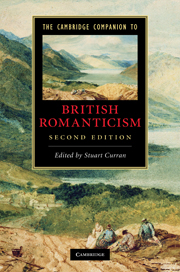Book contents
- Frontmatter
- 1 Romanticism and the “schools” of criticism and theory
- 2 Romanticism and Enlightenment
- 3 Poetry in an age of revolution
- 4 German Romantic Idealism
- 5 Romanticism and language
- 6 Culture’s medium: the role of the Review
- 7 Publishing and the provinces in Romantic-era Britain
- 8 Women readers, women writers
- 9 Romantic fiction
- 10 Romantic poetry: why and wherefore?
- 11 The sister arts in British Romanticism
- Guide to further reading
- Index
6 - Culture’s medium: the role of the Review
Published online by Cambridge University Press: 28 January 2011
- Frontmatter
- 1 Romanticism and the “schools” of criticism and theory
- 2 Romanticism and Enlightenment
- 3 Poetry in an age of revolution
- 4 German Romantic Idealism
- 5 Romanticism and language
- 6 Culture’s medium: the role of the Review
- 7 Publishing and the provinces in Romantic-era Britain
- 8 Women readers, women writers
- 9 Romantic fiction
- 10 Romantic poetry: why and wherefore?
- 11 The sister arts in British Romanticism
- Guide to further reading
- Index
Summary
During the last quarter of the twentieth century social historians and historical critics cautiously developed a language for studying the arts that breaks out of a narrowly aesthetic vocabulary. We became interested not so much in literature or art or music, not even in “the arts” altogether, but in a given society's cultural production. The full consequences for our sense of how individual arts or artists operated at any particular point in time will take a very long time to absorb. Part of the problem here is that old-style “literary history” and “art history” constructed a continuous narrative with claims, which now seem remarkably fragile, to explain where art came from. Powerful figures within the art world were held to wield the infl uence of despots. In order to understand younger artists it was enough to show who they copied and who they reacted against. Cultural history is of course far more impersonal than this. It also registers types of event, and of historical change, held by literary history to be of secondary significance, such as the passing or the repeal of laws affecting state censorship or copyright, and the two or three major advances in the technology of book-production. During the eighteenth century a combination of legal, financial, and industrial factors produced a huge expansion in the bulk and influence of print culture, working one of those transformations that truly deserve the term revolutionary: yet the century in which it took place is notorious for being one of the quietest on literary-historical record.
- Type
- Chapter
- Information
- The Cambridge Companion to British Romanticism , pp. 127 - 152Publisher: Cambridge University PressPrint publication year: 2010
- 7
- Cited by



